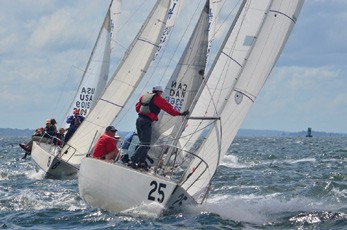By David Dellenbaugh
G ood boatspeed is perhaps the single most important ingredient for success in sailboat racing, no matter where you are on the racecourse. When you’re going fast you can sail around other boats, avoid bad air, point high, make up for mistakes and generally do a lot of things that make you look smart.
ood boatspeed is perhaps the single most important ingredient for success in sailboat racing, no matter where you are on the racecourse. When you’re going fast you can sail around other boats, avoid bad air, point high, make up for mistakes and generally do a lot of things that make you look smart.
When you approach the first mark, it’s easy to get distracted by everything that’s happening. There are usually lots of boats around, for example, and it often seems like half your crew is getting the chute ready. However, when you are distracted, most likely you aren’t sailing your boat too quickly. Therefore, as you get closer to the mark, it’s very important to stay focused on maintaining speed, especially for the helmsperson and sail trimmers. © Stephen Cloutier/photogroup.us
This applies, of course, when you’re approaching and rounding the windward mark. Speed here is critical because boats are so close together, and it would be easy to go slow in the disturbed air and water. If you’re fast, you may just be able to cross a starboard tacker, and that could mean the difference between rounding fifth or 15th. So when you get close to the mark, concentrate on keeping your boat going fast. Here are some tips on how to do this:
Let the helmsperson focus on speed. Unless you’re sailing a singlehander, try to have one or two crewmembers take care of all your mark-rounding preparations like setting the pole, looking for the next mark and so on. By doing this, you allow the helmsperson to concentrate on keeping the boat going fast.
Be ready and willing to “shift gears.” As you approach the mark, you will often sail into areas of bad air or choppy water. To keep going fast, you must anticipate this and shift “down” by easing sheets, bearing off a little and so on. This ability to “power up” at the right times is key to maintaining good speed relative to the boats nearby.
Allow only one crew to move around. A common mistake I see at windward marks is too many people running around on boats. Though there are certain things that must be done before you reach the mark, you don’t want to take weight off the rail when it’s windy or make the boat bounce around when it’s light. In all conditions, this movement is a distraction to the sail trimmers and helmsperson. When it’s really necessary to perform a job, try to have only one person move.
Avoid bad air. Dirty air from other boats may offer the biggest obstacle to good boatspeed as you approach the windward mark. To avoid this, look ahead for lanes of clear air before you get too close to the mark. A port-tack approach may be risky, but will often give you the best chance of clear air.
Prepare for choppy water. The water near a windward mark is usually pretty bumpy, thanks to converging sailboats and spectator craft, so get ready for this. Make your sails fuller, keep crew weight low and don’t pinch!
Be careful about pinching. When you’re tight on the layline, it may be faster to pinch around the mark than to make two tacks. But don’t get carried away. Don’t even think about pinching until you are within three or four lengths of the mark. And if you’re in bad air, pinching will probably not work at all.
Execute good maneuvers. Tacks are always important, but they’re especially crucial near the windward mark. That’s because a good tack can mean the difference between rounding ahead of or behind a pack of boats. So make every maneuver as efficient as possible. Don’t let up or get sloppy just because you’re almost at the mark.
Just sail fast to the mark! It seems like there’s a lot you must do before the mark. But your main goal is simply to get around the mark quickly, so don’t worry about the little things. For example, it’s better to round the mark without your spinnaker pole in place than it is to set your pole before the mark but lose five boats because this made you slower. Go fast first!
This article originally appeared in David Dellenbaugh’s Speed & Smarts, The newsletter of how-to tips for racing sailors. If you want to sail faster and smarter, log onto SpeedandSmarts.com.
A resident of Easton, CT, Dellenbaugh was tactician and starting helmsman for America3’s successful defense of the America’s Cup in 1992. He’s a Lightning World Champion, two-time Congressional Cup winner, seven-time Thistle National Champion, two-time winner of the Canada’s Cup, three-time Prince of Wales U.S. Match Racing Champion, and a winner of the U.S. Team Racing Championships for the Hinman Trophy.




